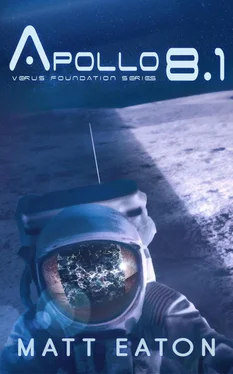The capsule hatch hangs open as if waiting for him to enter, but it’s just out of easy reach. He’ll have to leap off the gantry to get to it. Meaning he gets one shot. If he fails to get a firm hold of the hatch, he’ll just bounce off into space — a distinct possibility in a spacesuit that renders him about as agile as the Michelin man.
But he’s not going to die wondering. He launches himself from the platform to the hatch, madly scrambling for a handhold. He clamps one glove inside the internal door mechanism to steady himself while reaching inside the cabin with the other. He keeps hold of the hatch, but misses the mark with his other hand. For an awful moment, he finds himself hanging in space, terrified the sudden reverse in his momentum from his impact will bounce him loose. But he maintains his grip. Slowly, one leg at a time, he works his way inside the cabin.
He pulls the hatch closed and locks it down, sealing himself inside an airless metal box. Everything looks exactly as he remembers it. He flips a switch to fill the cabin with air, then checks his RCS. Five minutes of air left. He can already feel the suit’s air supply beginning to thin. He’s starting to labor more to take a breath. A few more minutes, and he’ll be in the hypoxia zone. The hiss of air gradually filling the cabin is music to his ears. He waits as long as he can before daring to remove his helmet, swallowing the feeling that it’s an act of suicide.
The helmet clicks loose and he hears the air from his suit rush through the opening as the pressure equalizes. The cabin air is thin but breathable, and getting denser by the second. Thank God.
He unstraps the PLSS life support unit from his back, unplugs it from his suit and jams it behind the row of seats. Then he straps himself into the central seat to maximize his reach for the controls. Normally, they are operated by two people.
Somehow, the systems are already switched on. The ship’s DSKY computer interface is blinking. An impossible thought occurs to him. He punches a command into the guidance computer. It gives him a Mission Elapsed Time readout of 93 minutes.
That can’t be right. Flight time from Earth to Mars would be measured in months, not minutes. Lord knows where this so-called mission began, but he’s pretty damn sure now he wasn’t on board this ship for liftoff. Certainly not for a NASA-style liftoff. Too noisy. Too easily detectable. That’s not how Bermuda goes about its business.
Did the Russians piggyback the CSM to Mars on one of their ships? Even assuming that’s the case, how did the CSM come with him through the monolith’s transportation gateway?
He decides not to look a gift horse in the mouth. First things first — he flicks the switch to decouple the probe from the platform. As he does, the orbiting platform shakes violently, pushing against the CSM and propelling it into space. It’s a terrifying jolt, but it buys him a few minutes to work out his next move. Even detached from the gantry, he can feel the outer atmosphere buffeting the ship. That is way too close for comfort. He needs more time.
He also needs to pick a destination. A landing on the planet below being the most obvious choice. Yet there’s no way he can simply throw himself into a re-entry sequence on a wing and a prayer. If he doesn’t nail the re-entry corridor precisely, he’ll either burn up or bounce straight off the outer atmosphere. Meaning he has to fire up the main SPS engine to push the ship into a higher orbit. That way he’ll have time to either work out a re-entry vector… Or plot a flight path back to Earth, assuming that really is Mars down there.
Navigation and guidance are going to prove an interesting challenge. Jim Lovell had been navigator on Apollo 8. Borman’s working of the Apollo Guidance Computer had always been in close coordination with Lovell. His only hope now is that somehow this AGC is programmed to get him safely down to the surface. Logic tells him that’s impossible, but then again, all normal parameters of logic vanished a while back. Logic says the planet in the window should be red, not blue.
Logic tells him he shouldn’t be here at all.
He checks the computer program counter. It tells him he’s in the initial stages of the EI phase… Apollo-speak for entry interface — the re-entry sequence. But when he sees what the computer tells him to do next, it makes him smile. Apparently somebody is looking out for him. The program says the first stage of the EI is a burn of the SPS engine to position the capsule in an elliptical orbit. It’s precisely the move he would be making even if he had no computer to guide him. A textbook Apollo EI sequence.
And the computer knows exactly what’s required.
Someone’s been thinking ahead. The AGC has been programmed to get him out of an unstable Martian orbit. He checks the program to ensure the computer program will fire the SPS without his help. An alarm sounds, telling him the burn needs to be executed in thirty seconds. The computer needs his confirmation to carry it out. He quickly hits the command to execute, and scrambles to strap himself into a chair. His only hope is that the ship’s inertial measurement unit will accurately tell the computer the spacecraft’s speed, altitude, and horizontal attitude. He only gets one go at this.
The first Apollo missions were unmanned. The computer got them safely through re-entry. They were closely monitored and controlled from the ground, but onboard navigational systems had functioned within acceptable tolerances. Those same onboard systems are now his lifeline. He’ll be flying on auto-pilot, just like they do it in Russia. He can’t help smiling at the irony. He checks again. The DSKY interface confirms the program is running. No failure warning flash. A moment later, he feels a bump as RCS thrusters fire to readjust the module’s attitude to point the ship’s nose away from Mars. He catches a glimpse of blue flashing past the window as the module moves into a better alignment for re-entry. The SPS is just point and fire — you need to aim it right before lighting the candle.
Then the SPS fires up and the CSM hits maximum acceleration, pushing him deep into his seat. The burn continues for about ninety seconds, carrying him well clear of the launch platform and the remains of the Martian moon. The AGC tells him he’s now orbiting Mars at a speed of 25,969 feet per second. It’s way slower than Apollo 8’s EI approach speed of 36,303f/s, but that’s OK — on 8 they were coming home from the Moon. And in terms of his chances of landing on Mars safely, slower is probably much better.
Without even bothering to give it serious consideration, he dismisses the notion of heading for Earth. He would run out of fuel, food, and water long before making the distance, and that is assuming the Earth he left is even out there. That planet he’s orbiting may not be Mars. He could be somewhere else entirely. Landing is his only realistic survival option.
They sent him here for a reason. No going back now.
He orbits the planet three times while he does his best to check and double check the computer’s calculations for the best EI corridor. When he thinks he has the numbers straight, he goes around two more times, peering out the window to get a look at what’s on the ground. Each time he passes over the Phobos platform, it seems to be glowing brighter, painting a long red streak across the Martian sky. Can’t be long before it burns up. And he won’t want to have his chutes opening anywhere near that fiery catastrophe. He scans the Martian surface for the best place to come down as far as possible away from the remains of the moon. After the adrenalin rush of his time on Phobos, it feels comforting to be in much more familiar surroundings, even if the world below is entirely foreign. Will the air be breathable? He’ll find out soon. He picks a landing place and punches the EI sequence into the computer. Flips the CSM around so he’s flying backwards, then types in the command telling the computer to fire up the SPS for the re-entry burn. Heart in his mouth, he hits the button to execute.
Читать дальше












